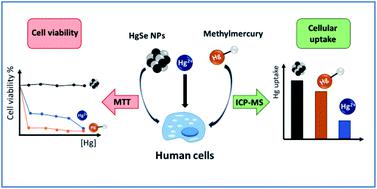当前位置:
X-MOL 学术
›
J. Anal. At. Spectrom.
›
论文详情
Our official English website, www.x-mol.net, welcomes your feedback! (Note: you will need to create a separate account there.)
Quantitative assessment of cellular uptake and differential toxic effects of HgSe nanoparticles in human cells
Journal of Analytical Atomic Spectrometry ( IF 3.4 ) Pub Date : 2020-07-03 , DOI: 10.1039/d0ja00162g Laura Cid-Barrio 1, 2, 3, 4 , Diego Bouzas-Ramos 1, 2, 3, 4 , Alfonso Salinas-Castillo 4, 5, 6, 7 , Yasumitsu Ogra 8, 9, 10, 11, 12 , Jorge Ruiz Encinar 1, 2, 3, 4 , José M. Costa-Fernández 1, 2, 3, 4
Journal of Analytical Atomic Spectrometry ( IF 3.4 ) Pub Date : 2020-07-03 , DOI: 10.1039/d0ja00162g Laura Cid-Barrio 1, 2, 3, 4 , Diego Bouzas-Ramos 1, 2, 3, 4 , Alfonso Salinas-Castillo 4, 5, 6, 7 , Yasumitsu Ogra 8, 9, 10, 11, 12 , Jorge Ruiz Encinar 1, 2, 3, 4 , José M. Costa-Fernández 1, 2, 3, 4
Affiliation

|
Bio-formation and biodistribution of mercury selenide (HgSe) nanoparticles (NPs), as the ultimate metabolic product in the Hg detoxification pathway, is an important environmental and toxicological issue not well understood nowadays. In this work, we revealed for the first time the cellular uptake and accumulation of HgSe NPs in one embryonic and one tumour human cell line (HEK 293 and HeLa). For this purpose, HgSe NP standards were synthesized, well characterized and surface-engineered to endow them with stability in aqueous and cellular culture media. The native fluorescence emission of the HgSe NPs enabled the assessment of their cellular distribution and constituted the starting point of a pioneering comparative study of the cytotoxicity of HgSe NPs and that induced by the widely studied inorganic mercury(II) and methylmercury in the two human cell lines. The three Hg species investigated significantly differed in their degree of toxicity. While HgSe NPs did not induce a significant effect in cell viability, even at relatively high Hg concentrations; lower exposure levels of Hg2+ and MeHg+ alone, and even in the presence of other Se species (selenite), caused acute cytotoxicity. A negligible release of Hg2+ from the NP surface was observed under the incubation conditions used. Cellular uptake of HgSe NPs and Hg2+ and MeHg+ compounds was quantified also by ICP-MS. Results indicated that Hg incorporation when cells were exposed to the same Hg concentration added as nanoparticles (41%) and MeHg+ (36%) is quite similar, instead of the decrease observed for Hg2+ uptake (8%). Therefore, the null cell cytotoxicity effect observed for HgSe NPs cannot be ascribed to a lower Hg internalization in the cells.
中文翻译:

定量评估HgSe纳米粒子在人体细胞中的细胞摄取和不同的毒性作用
硒化汞(HgSe)纳米颗粒(NPs)作为汞排毒途径中的最终代谢产物,其生物形成和生物分布是当今尚不十分了解的重要环境和毒理学问题。在这项工作中,我们首次揭示了HgSe NP在一种胚胎和一种肿瘤人类细胞系(HEK 293和HeLa)中的细胞摄取和积累。为此,合成了HgSe NP标样,对其进行了很好的表征和表面处理,使其在水性和细胞培养基中具有稳定性。HgSe NPs的天然荧光发射能够评估其细胞分布,并构成了HgSe NPs和广泛研究的无机汞诱导的细胞毒性比较研究的开创性比较研究的起点(II)和两种人类细胞系中的甲基汞。所研究的三种汞物种的毒性程度显着不同。HgSe NP即使在相对较高的Hg浓度下也不会对细胞活力产生显着影响。单独的Hg 2+和MeHg +较低的暴露水平,甚至在存在其他硒物种(亚硒酸盐)的情况下,也会引起急性细胞毒性。在所使用的孵育条件下,观察到Hg 2+从NP表面的释放微不足道。HgSe NPs和Hg 2+和MeHg +化合物的细胞摄取量也通过ICP-MS进行定量。结果表明,当细胞暴露于与纳米颗粒(41%)和MeHg +(36%)非常相似,而不是观察到Hg 2+吸收的减少(8%)。因此,对于HgSe NPs观察到的无效细胞细胞毒性作用不能归因于细胞中较低的Hg内在化。
更新日期:2020-09-02
中文翻译:

定量评估HgSe纳米粒子在人体细胞中的细胞摄取和不同的毒性作用
硒化汞(HgSe)纳米颗粒(NPs)作为汞排毒途径中的最终代谢产物,其生物形成和生物分布是当今尚不十分了解的重要环境和毒理学问题。在这项工作中,我们首次揭示了HgSe NP在一种胚胎和一种肿瘤人类细胞系(HEK 293和HeLa)中的细胞摄取和积累。为此,合成了HgSe NP标样,对其进行了很好的表征和表面处理,使其在水性和细胞培养基中具有稳定性。HgSe NPs的天然荧光发射能够评估其细胞分布,并构成了HgSe NPs和广泛研究的无机汞诱导的细胞毒性比较研究的开创性比较研究的起点(II)和两种人类细胞系中的甲基汞。所研究的三种汞物种的毒性程度显着不同。HgSe NP即使在相对较高的Hg浓度下也不会对细胞活力产生显着影响。单独的Hg 2+和MeHg +较低的暴露水平,甚至在存在其他硒物种(亚硒酸盐)的情况下,也会引起急性细胞毒性。在所使用的孵育条件下,观察到Hg 2+从NP表面的释放微不足道。HgSe NPs和Hg 2+和MeHg +化合物的细胞摄取量也通过ICP-MS进行定量。结果表明,当细胞暴露于与纳米颗粒(41%)和MeHg +(36%)非常相似,而不是观察到Hg 2+吸收的减少(8%)。因此,对于HgSe NPs观察到的无效细胞细胞毒性作用不能归因于细胞中较低的Hg内在化。


























 京公网安备 11010802027423号
京公网安备 11010802027423号